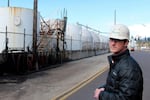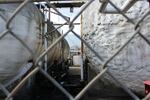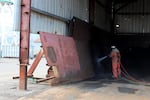
North Portland resident Stacey Schroeder stands on the bluff along WIllamette Boulevard overlooking Swan Island and the Daimler Trucks North America plant, as her daughter picks dandelions in the distance. Schroeder and other neighbors blame Daimler for paint odors in their neighborhood, and they blame the Oregon Department of Environmental Quality for failing to fix it.
Tony Schick / OPB/EarthFix
Adam Bartell felt like a crackpot for complaining about air pollution in his neighborhood.
The smell of paint fumes in University Park was potent, frequent and eventually intolerable.
He smelled it in the morning when he took the kids to school. He smelled it in the afternoon when he picked them up.
But when he tried to tell someone who could stop it, he felt ignored.
“You felt you were actually in a paint booth without any kind of respirator,” Bartell said. “And it just seemed so strange. You look around and there’s nobody painting within 15-20 feet and yet it smells as if somebody’s just …”
He held a hand up and mimicked the sound of a spray can.
“Very clearly it was paint,” he said.
So he informed state regulators -- repeatedly. Over the past six years, Bartell and his wife, Jill, have filed almost 40 complaints about the smell with the Oregon Department of Environmental Quality.
“You sort of wonder how long you have to say the same thing before somebody's going to do something," he said.
Related: Washington More Responsive Than Oregon on Air Complaints, But Problems Remain
Bartell’s neighborhood sits on a bluff overlooking North Portland’s Swan Island industrial district. Below the bluff, the German vehicle manufacturing company Daimler operates a factory assembling and painting freight trucks. Convinced they are being exposed to dangerous paint and solvent fumes, neighbors have filed hundreds of complaints about the company. Since 2010, Daimler has been the target of more complaints than any other facility in Oregon.
For years, DEQ let complaints fester with little response, Bartell and his neighbors said.
An EarthFix examination found Oregon regulators routinely fail to conduct thorough investigations of air and odor complaints. They do less than regulators in neighboring California and Washington to resolve complaints and control nuisance odors.
As Portland reckons with revelations about toxic hotspots that were only recently detected, complaints around Swan Island show how regulators have failed to remedy even known problem areas.
Daimler's neighbors tried and failed to convince the agency to require more pollution controls on the company's operating permit when it came up for renewal. They asked the company for voluntary fixes, but those talks stalled. They called their elected officials. The governor organized a task force to negotiate a solution, but Daimler remained unmoved. Five years later, the smell is still there and little has changed
Last year the state finally investigated allegations that paint fumes were causing a neighborhood nuisance. DEQ now confirms Daimler is the source of the paint smell. But the state's report, which has been criticized for having a flawed methodology, downplayed the problem and concluded the odors were not a nuisance. The report has stoked frustrations.
“We have a company that is not going to change unless you force them to change,” Oregon House Speaker Tina Kotek, D-Portland, told regulators at a recent community meeting.

Neighbors of Daimler Trucks North America protest the company's new headquarter opening. Residents near the Swan Island truck maker have complained for years about persistent paint odors, but say little has changed.
Cassandra Profita / OPB/EarthFix
Staff limitations hinder response
Environmental regulators encourage citizens to file complaints, calling them "vital for effective enforcement," but many of those who have regularly filed complaints to DEQ describe feeling ignored, discounted or belittled.
EarthFix’s review of records found that complaints about state-regulated facilities rarely result in inspections or enforcement. The agency has received more than 2,000 such air quality complaints since 2010. It decided an inspection was needed on fewer than 5 percent of them.
DEQ officials say not all complaints merit an on-site inspection and that they do not have the staff to respond to all complaints in person. They handle many of them with phone calls to complainants and plant managers.
“The conversations that occur are equally important to going out to the site,” DEQ complaint system manager Mike Kortenhof said. “They know they have to report to us the answers to the questions. It’s not like it gets put off because it’s a phone conversation.”
When a polluter becomes the source of ongoing odor or emissions complaints, neighbors have found no relief in turning to state regulators for help. At least 17 facilities were the source of 10 or more complaints to DEQ over the past six years. In just one of those cases did complaints lead to enforcement action -- not for toxic emissions but for sawdust that blew onto nearby properties from the Bright Wood mill last year in Central Oregon. In the rest of the cases, only when neighbors secured voluntary agreements outside state enforcement did they make progress.
Not all agencies are so hands-off.
In total, more than 120 facilities in Oregon and Washington have received 10 or more complaints since 2010. Unlike the Oregon DEQ, regional air agencies in Eugene, Olympia, Spokane, Seattle and the northwest and southwest corners of Washington took enforcement action on many of these cases after following up on complaints.
Related: Washington More Responsive Than Oregon on Air Complaints, But Problems Remain
In some states, including Texas and California, regulators inspect complaints within a day of receiving them. After that, experts say, it’s unlikely they’ll find the source of the problem and be able to find a violation.
Complaints about nuisance odors are notoriously difficult to verify and enforce, regulators say. Each state takes a different approach.
While the Oregon DEQ has shied away from enforcing nuisance odor problems, agencies in other states including Washington and California regularly use nuisance rules to crack down on pollution. Despite having nuisance rules on the books for over a decade, DEQ still cannot show that it has a functioning system for enforcing them.
Neil Carman, clean air director for the Sierra Club in Texas and a former Texas air quality investigator, said he was shocked at the lack of responsiveness he found in Oregon.
“Their whole complaint process seemed to be not driven and motivated to protect human health but to protect special interest, to protect big business and industry," said Carman, who became familiar with Oregon's approach to clean air regulation while consulting for the Portland-based citizen-activist group, Neighbors for Clean Air.”
“Oregon DEQ needs to respond to complaints in an aggressive manner, and rapidly, and they need to not shy away from issuing nuisance violations,” Carman said, noting he won many nuisance cases in Texas with help from the state attorney general.“ Judges will listen to investigators. They’ll listen to citizens who come and testify.”

University of Portland professors Laurie McLary and Jeff White have been dealing with paint odors in their neighborhood for more than a decade. McLary said the Oregon Department of Environmental Quality did not take her complaints seriously, and that she felt she and other neighbors were doing the job of environmental regulators.
Tony Schick / OPB/EarthFix
‘You couldn’t really breathe’
In the spring of 2001, Jeff White and Laurie McLary were out for a jog along the bluff in North Portland when suddenly they hit a patch of bad air.
“You couldn’t really breathe,” White said.
That was the first time they remember encountering the paint smell. It seemed so close, they thought, it had to be from someone’s garage.
But it’s been there off and on — at home, at their University of Portland offices, during bike commutes back and forth — ever since.
Industrial smokestacks rise high in the air to reduce the impacts of pollution on the ground. But local topography puts many homes just above and just downwind of smokestacks on Swan Island.
Neighbors describe the smell as assaulting. It makes their eyes water, gives them headaches, makes them dizzy.
“You can taste it, on the back of your tongue. It’s intense,” McLary said.
Odor complaints often transcend nuisance.
Complaints about a glass maker in Southeast Portland preceded revelations about arsenic and cadmium hotspots. Complaints about the ESCO steel foundry in Northwest Portland were followed by state modelling showing air toxics above health benchmarks. The same goes for AmeriTies West, company treating railroad ties in the Columbia Gorge.
“The sources of odors are often the sources of air toxics,” said Nina DeConcini, DEQ's Northwest Region administrator. “Not always, but they track. They do track, closely in some cases.”
State air pollution modeling puts McLary's neighborhood at nearly 100 times the state's health benchmarks for exposure to toxic contaminants, with solvents one of the significant sources.
Odor alone doesn’t mean the air is toxic, experts say, but paint and solvent smells are often an indicator of volatile organic compounds – chemicals that includes the cancer-causing formaldehyde and benzene, most of which can cause myriad health effects from long-term exposure.
DEQ monitored air toxics in the neighborhood for more than a year but has yet to release the results. The agency says it expects to do so next month – well over a year after the monitoring began. Meanwhile, officials have published the results of monitoring near Portland glassmakers in a matter of weeks.
Jim Houck has studied air quality since the 1970s and led students in odor studies as an adjunct professor at the University of Portland. Houck suspects that residents along Willamette Boulevard are being exposed to volatile organic compounds, many of which are toxic or carcinogenic.
“The exposure that people that live along that area have had is probably over many decades and low level chronic exposures are not well understood but clearly they’re not good,” Houck said.
McLary filed many complaints with DEQ in the years since she first smelled paint odors. Agency employees encouraged her to log complaints whenever she smelled the odor, saying it helped them track the issue.
Lately, she hasn’t filed any.
“It’s kind of felt somewhat futile,” she said. “I fill out the forms and send them off and they go into the black hole and … what then?”

Neighbors of Daimler Trucks North America, a truck maker in Portland's Swan Island industrial district, protest the plant's emissions at a recent unveiling of new headquarters.
Cassandra Profita / OPB/EarthFix
Oregon’s Problem
When someone calls to complain to the Oregon DEQ, sometimes they get a dispatcher and sometimes they get an automated hotline.
A dispatcher takes the information from that call, or from an online form, and relays it to a staff member, who calls the suspected source to investigate potential problems. The time between a complaint and response can take several days, weeks, a month or longer, according to agency staff.
The goal is to make sure every complaint gets a response. But the agency simply does not have the staff to respond more quickly or to inspect every complaint, said DeConcini, a senior manager in Portland. DEQ is funded by permit fees and has no dedicated funding for complaint response. To do more, the agency would need more money from the state’s general fund or to carve it out of an already struggling permit program.
Others disagree that resources are the primary reason for DEQ’s lagging responses.
“It’s culture,” Neighbors for Clean Air board member Nick Bouwes said. Now retired, Bouwes spent nearly two decades at the U.S. Environmental Protection Agency, where he developed a risk screening tool for toxic chemicals.
“It wouldn’t have taken a lot of resources for them to seriously listen to what people were complaining,” he said. “They seem to be more sympathetic to the business interest than they were to what the people were saying. Sometimes they even try to minimize the legitimacy of the complaints.”
After a U.S. Forest Service moss sampling study discovered toxic hotspots that the state had failed to detect, DEQ is in the midst of an overhaul. The agency is hiring a new director, replacing its air quality manager in Portland and developing a new system of air quality permitting based on human health — protections already established in California and Washington.
All of this has come in the midst of public outcry over the agency’s approach to regulating air pollution.
“We need to do more. I would absolutely echo that sentiment,” DeConcini said.
DeConcini said she hopes the overhaul will also lead to fewer complaints and better responses.
“I think we need to look at this from the perspective of not only how do we respond better but how do we do it earlier upstream,” she said. “I think this health-based, risk-based program to address air toxics at the local level is a really good idea.”
In California, a state considered a leader in air quality, investigators aim to respond to all complaints within an hour. The San Francisco Bay Area, for instance, has 60 inspectors on duty at all times, each assigned to a particular area. Fines for nuisance odors can be as high as $50,000 per day.
In Washington, the state Department of Ecology does not have the ability to investigate all complaints. But Washington has eight regional air agencies covering most of the state.
Stu Clark, who heads Ecology’s air quality division, said having regional air agencies improve responses because regulators are closer to the people they serve.
“If we had to run everything out of Olympia or Spokane or Yakima, our regional offices and headquarters, there’s hundreds of miles between where we are and where the people are,” Clark said. “Oregon has that problem.”
Uri Papish directs the Southwest Clean Air Agency, one of Washington’s eight regional operations. Papish, a former air quality manager for DEQ, said he sees a stark difference in the emphasis his current agency puts on complaints compared to DEQ.
“We get a complaint, we have somebody jump in a car, and within an hour, we’re out to a site,” Papish said. “A lot of enforcement is complaint driven. That’s how you find out about stuff.”

Alan Sprott, Vigor’s vice president of environmental affairs, in front of the company's oily wastewater treatment area. Vigor voluntarily shut down its treatment of third-party wastewater, which generated $1 million in annual revenue, because of neighbor complaints about the odor.
Tony Schick / OPB/EarthFix
Good neighbor, bad neighbor
“Can you give me your definition of a good neighbor?”
Stacey Schroeder likes to ask that of the Daimler plant’s top managers.
Schroeder, a mother of two and longtime North Portland resident, has been a driving force for better air in her neighborhood.
In early April Daimler’s newest plant manager, Mike Foley, had been on the job a little more than a week when he joined Schroeder and other neighbors at North Portland’s Historic Kenton Firehouse to hear an update from state regulators.
“What’s a good neighbor?” she asked him across a crowded room.
“I don’t have enough knowledge about it to …” Foley began to answer, but she cut him off.
“You don’t know what a good neighbor is?” she asked.
“Not in this context, no,” he said.
Schroeder does. She says Vigor Industrial, a shipyard on Swan Island, did all the things she and others asked Daimler to do.

Tanks at the Vigor Industrial shipyard's oily wastewater treatment operation sit behind a cyclone fence. The company shut down its treatment of third-party wastewater for the benefit of neighbors, who complained about the odor.
Tony Schick / OPB/EarthFix
There’s a cyclone fence at the shipyard that holds a row of fuel and water tanks like a crate full of giant, rusty softballs. It’s there that the company abandoned $1 million in annual revenue because of neighbor complaints.
The company treated other people’s waste water in the tanks, and it stunk. The petroleum-heavy smells were often nauseating, neighbors said.
When Vigor began getting calls from DEQ about neighborhood odor complaints, it launched a full-on investigation.
Alan Sprott, Vigor’s vice president of environmental affairs, led the company’s efforts to pay for odor surveys, install weather monitors and test its emissions to figure out how odors from the shipyard affected the surrounding neighborhood.
They found the wastewater treatment was the culprit for most complaints. So they shut it down.
“For us, it was the right thing to do to show respect for the folks up on the bluff,” Sprott said.

A worker at Vigor Industrial uses a wet blast technique to strip paint off a piece of ship before its is recoated with fresh paint. Vigor switched to using this technique to reduce the amount of dust and particles it emits in an effort to improve air quality for neighbors.
Tony Schick / OPB/EarthFix
Vigor now halts certain practices when weather data shows a temperature inversion could send emissions toward nearby residential areas. As a result, many neighbors said they no longer smell the odor they came to associate with Vigor.
Last week, the company and neighborhood finalized a Good Neighbor Agreement for these voluntary steps and others – such as reducing diesel emissions from idling ships and cutting dust and particulate emissions using a new technique for sandblasting the paint from old ships.
Daimler has not taken such steps and has not explained why. The company declined requests for an interview or a facility tour.
A spokesman for the agency issued a statement via email. It noted the steps Daimler has taken over the years to reduce emissions. Those included conducting its own air sampling and switching to less hazardous products, but the complaints have not stopped.
Daimler could install install oxidizers to remedy the problem, according to DEQ. Those devices combust hazardous pollutants like volatile organic compounds into carbon dioxide and water. The company is not required to do so.
Daimler “is committed to minimizing our environmental footprint and had taken many steps over the years to dramatically reduce our emissions,” spokesman David Giroux wrote, adding that Daimler’s actions “made the company part of the solution.”
Oregon state regulators are increasingly promoting “good neighbor agreements” to resolve conflicts between polluters and nearby residents and businesses. The situation on Swan Island shows the success of such agreements is at the mercy of private industry and creates a patchwork of inconsistent regulations.
When a Northwest Portland neighborhood group signed a pact for the steel foundry ESCO to voluntarily reduce emissions and reduce the hundreds of complaints against the company, it was widely praised and touted as a national model.
Many who live in the neighborhood were less impressed. The complaints have continued.
Mary Peveto and her advocacy group Neighbors for Clean Air negotiated pacts with ESCO, Intel and Vigor Industrial. Peveto said the agreements, while a victory for advocates, are an indictment of state rules.
“Good neighbor agreements are really a flawed tool in a really lacking toolbox to have to deal with these situations,” Peveto said.
Neighborhood advocates failed when Daimler’s permit was up for renewal. They failed in negotiations for voluntary controls, even with backing from the Oregon governor’s office and speaker of the House.
They put their fading hope in the state's nuisance odors strategy, which proved to be folly.

University Park neighborhood children play in field where an Oregon Department of Environmental Quality air toxics monitor sat for more than a year. A poster from the advocacy group Neighbors for Clean Air encourages residents to report what they smell in the area. Concerns about persistent paint odors have plagued the neighborhood for years.
Tony Schick / OPB/EarthFix
The nuisance
The neighborhood above Daimler pushed DEQ further than it’s ever gone toward enforcing rules that say a company can’t be a nuisance to its neighbors.
The DEQ’s investigation into nuisance odors from Daimler was, if you ask the agency, more objective and thorough than anything it’s accomplished before. It determined there was no nuisance.
“I know it’s deeply unsatisfying for people who live in the neighborhood. We fully appreciate the irritation and the impact on people’s lives,” DeConcini said. “We also weren’t going to come up with some sort of fudged number simply to validate the tremendous emotion and frustration people are feeling.”
If you ask University of Portland professor Ted Eckmann, a fudged number is exactly what they have.
“This wouldn’t pass even undergraduate lab reports, really,” Eckmann said of DEQ’s study.
During the months DEQ was studying odors from Daimler, Eckmann and his students were in the midst of their own year-long study of the issue. State investigators made 760 total attempts to detect odor. Eckmann’s students made nearly 24,000.
DEQ found odors during 3 percent of its observations. Eckmann’s study found during winter months, odor detections near Daimler were as high as 20 percent.
Eckmann said the state created a biased sample by testing inconsistently: DEQ staff took more samples during months and times of day with fewer reported odors. In other words, they skewed the results low.
The state also determined Daimler was not a nuisance based in large part on its 3 percent finding, but regulators have no benchmark for what percentage would merit a nuisance finding.
For those reasons, Eckmann told regulators their report was “deeply flawed” and “meaningless.”
DEQ staff have defended their methodology, saying their findings were not too dissimilar from Eckmann’s overall findings about the frequency of paint odors.
“Certainly we don’t think what we’re doing is perfect. But we are trying to apply a standard that is as close to an objective method as we can,” DeConcini said.
After seeing Eckmann’s research, Oregon House Speaker Tina Kotek sent a letter to DEQ asking them to re-investigate. Her district includes the neighborhood around the University of Portland where complaints about Daimler have been rampant. Last week the agency said it would re-open the case per Kotek’s request.
In her letter, Kotek described her constituents as feeling abandoned by the agency charged with safeguarding their community’s health and liveability.
“Now, more than ever, they expect the department to complete evidence-based investigations, utilizing all available credible data, to evaluate fully the negative impacts from regulated facilities,” Kotek wrote. “I expect nothing less as well.”